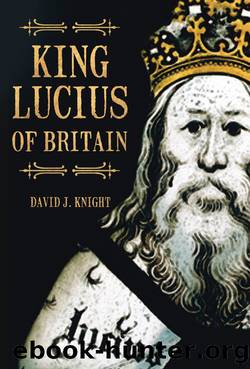King Lucius of Britain by David J Knight

Author:David J Knight
Language: eng
Format: epub
Tags: King Lucius of Britain
ISBN: 9780752474465
Publisher: The History Press
Published: 2012-02-22T00:00:00+00:00
THE SECOND-CENTURY ROMAN BASILICA OF LONDINIUM AND ST PETER-UPON-CORNHILL
One of the most striking features of Roman Londinium was its forum basilica. By c.100 it had become immense even by Roman standards, measuring 166m x 167m; approximately five times larger than the original structure. This may have been in response to Londinium advancing from the status of municipium to colonia.52 Of interest to our study is a sequence of observations regarding the relationship between St Peter-upon-Cornhill and the Roman basilica.
In 1934 Sir Robert Eric Mortimer Wheeler made an important point: there is every likelihood that the London basilica and forum were of the type represented at Silchester, Caerwent and elsewhere, and so approximated to the normal plan of the headquarters-building of a Roman fortress. In the military headquarters the central room at the back of the basilica was the official regimental shrine and it is likely enough that the corresponding room (emphasised at Silchester by an apse) at the back of the civil basilica fulfilled an equivalent function, as a sort of municipal chapel. Today, the high altar of St Peterâs, Cornhill, stands over the site of the central room at the back of the London basilica. Does St Peterâs thus represent, in all topographical literalness, a continuous tradition from the time when Christianity first became the official religion of Roman London, with an official altar in the old municipal shrine?53
In 1969 Merrifield wrote that the Roman basilica âserved as courts of justice, town hall, and public meeting-place, and would also have contained the curia, or local senate house, the position of which is not yet knownâ.54 In 1987 Peter Marsden published a composite plan of the early medieval structures on the forum and basilica site of London. Including the Saxon church of All Hallows he commented that St Dionis Backchurch, St Michael Cornhill and St Peter-upon-Cornhill âwere constructed on the ruins of the basilica and forum, though whether or not they reused standing Roman walls is not knownâ, adding âHowever, it is interesting that St Peter upon Cornhill church was allegedly founded in AD 179â.55
The northern extent of the basilica was not discovered until 1982 during excavations at 68 Cornhill, and subsequent excavation has established that by the early second century the northern range âcomprised a single row of offices and a long portico which ran the length of the Nave and North Aisle, sub-divided by nonstructural partitionsâ.56 One particular room (number 13 in Marsden is number 2 in Brigham, measuring 7.5m square57) had in situ dark blue wall plaster. Immediately west of this is a room (number 12 in Marsden58) underneath Gracechurch Street and overlain to the west by the eastern wall of St Peter-upon-Cornhill, covered in âyellow panels with a black border, on a yellow ground with touches of redâ.59
This room was given a tessellated floor at a raised level, suggesting it âmay have had a higher status than normal, possibly acting as an antechamber for the aedes or shrine-roomâ. It is possible this aedes âoccupied a central position in the Northern Range ⦠beneath the east end of the church of St Peterâs, Cornhillâ.
Download
This site does not store any files on its server. We only index and link to content provided by other sites. Please contact the content providers to delete copyright contents if any and email us, we'll remove relevant links or contents immediately.
| Military | Political |
| Presidents & Heads of State | Religious |
| Rich & Famous | Royalty |
| Social Activists |
Waking Up in Heaven: A True Story of Brokenness, Heaven, and Life Again by McVea Crystal & Tresniowski Alex(37493)
Empire of the Sikhs by Patwant Singh(22772)
We're Going to Need More Wine by Gabrielle Union(18640)
Hans Sturm: A Soldier's Odyssey on the Eastern Front by Gordon Williamson(18330)
Leonardo da Vinci by Walter Isaacson(12809)
The Radium Girls by Kate Moore(11626)
Tools of Titans by Timothy Ferriss(7823)
Educated by Tara Westover(7693)
How to Be a Bawse: A Guide to Conquering Life by Lilly Singh(7161)
Permanent Record by Edward Snowden(5545)
The Last Black Unicorn by Tiffany Haddish(5417)
The Rise and Fall of Senator Joe McCarthy by James Cross Giblin(5151)
Promise Me, Dad by Joe Biden(4911)
The Wind in My Hair by Masih Alinejad(4849)
The Crown by Robert Lacey(4577)
A Higher Loyalty: Truth, Lies, and Leadership by James Comey(4556)
The Iron Duke by The Iron Duke(4125)
Joan of Arc by Mary Gordon(3787)
Stalin by Stephen Kotkin(3728)
